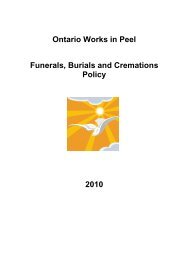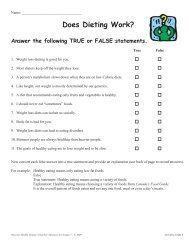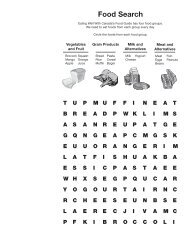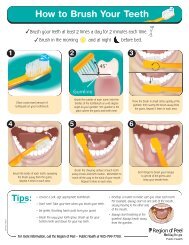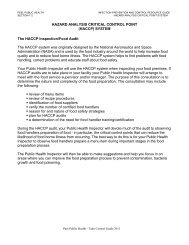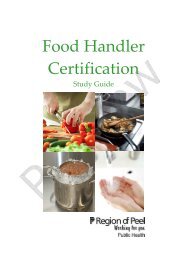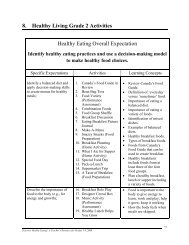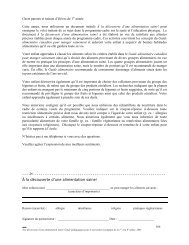Management of Norovirus - Region of Peel
Management of Norovirus - Region of Peel
Management of Norovirus - Region of Peel
Create successful ePaper yourself
Turn your PDF publications into a flip-book with our unique Google optimized e-Paper software.
PEEL PUBLIC HEALTH<br />
SECTION 4-18<br />
INFECTION PREVENTION AND CONTROL RESOURCE GUIDE<br />
DISEASE/ORGANISM SPECIFIC<br />
MANAGEMENT OF NOROVIRUS<br />
<strong>Norovirus</strong> is a common cause <strong>of</strong> viral gastroenteritis and has been linked to<br />
outbreaks <strong>of</strong> vomiting and/or diarrhea in institutions such as long term care<br />
homes, child-care centres, camps, schools and cruise ships.<br />
Humans are the only known reservoir <strong>of</strong> norovirus.<br />
Incubation<br />
<strong>Norovirus</strong> gastroenteritis has an average incubation period <strong>of</strong> 24-48 hours and<br />
lasts 24-60 hours.<br />
Symptoms<br />
Illness is characterized by an acute onset <strong>of</strong> nausea, vomiting, abdominal cramps<br />
and diarrhea. Headache, low grade fever and malaise are sometimes reported.<br />
Residents can experience vomiting alone. The dose required for illness to occur<br />
is relatively low (
PEEL PUBLIC HEALTH<br />
SECTION 4-18<br />
INFECTION PREVENTION AND CONTROL RESOURCE GUIDE<br />
DISEASE/ORGANISM SPECIFIC<br />
particles. Therefore the chance <strong>of</strong> isolating the virus is highest if the specimens<br />
are obtained as soon as the symptoms appear. Facilities should have policies in<br />
place that allow staff to collect specimens when symptomatic residents are<br />
identified. The likelihood <strong>of</strong> identifying the virus decreases as the time from onset<br />
increases. Specimens should be kept refrigerated after collection and during<br />
transport to the laboratory. The <strong>Peel</strong> Public Health Department will coordinate<br />
the submission <strong>of</strong> specimens with the Public Health Laboratory.<br />
Additional Precautions<br />
The following measures are recommended when norovirus is suspected:<br />
1. <strong>Peel</strong> Public Health should immediately be notified if an outbreak is<br />
suspected within the facility.<br />
2. Frequent hand hygiene must be performed with alcohol based hand rub (if<br />
hands are not visibly soiled) or with soap and water.<br />
3. Gloves should be worn in addition to hand hygiene. This will reduce the<br />
potential transfer <strong>of</strong> virus particles from clients to health care worker or<br />
from patient-to-patient via health care workers’ hands. Gloves must be<br />
changed between patient/client/resident contacts and hand hygiene<br />
performed immediately after gloves are removed.<br />
4. Contact precautions must be taken. Masks, fluid resistant gowns and<br />
goggles should be considered for persons who provide personal care in<br />
settings where spattering or aerosols <strong>of</strong> infectious material are present<br />
(e.g., vomiting, cleaning soiled bedpans, toilets and laundry,<br />
5. Contact precautions must also be taken by staff that clean areas<br />
substantially contaminated by faeces or vomit.<br />
6. Soiled linens should be handled as little as possible, and with minimum<br />
agitation. They should be laundered with detergent at the maximum cycle<br />
length and then machine dried.<br />
7. Environmental surfaces that have been soiled should be cleaned<br />
thoroughly, and then disinfected using an appropriate hospital grade<br />
disinfectant.<br />
8. Signage should be posted for visitors during times <strong>of</strong> high incidence in the<br />
community. The signage should advise ill persons not to visit and to<br />
encourage all visitors to clean hands upon entering the building.<br />
<strong>Peel</strong> Public Health - Take Control Guide 2011
PEEL PUBLIC HEALTH<br />
SECTION 4-18<br />
INFECTION PREVENTION AND CONTROL RESOURCE GUIDE<br />
DISEASE/ORGANISM SPECIFIC<br />
9. Symptomatic residents should be placed on contact precautions (gown<br />
and gloves) for direct care (e.g. bathing, changing incontinent residents).<br />
Several reports have identified transmission during outbreaks due to<br />
aerosolization when the resident vomits. For this reason, staff may choose<br />
to wear a mask when cleaning body fluid spills (e.g. vomitus, feces).<br />
10. Symptomatic residents should be cohorted if single room is not available.<br />
Residents should remain in their rooms and have staff dedicated to their<br />
care. Staff should not care for asymptomatic residents if assigned to<br />
residents with possible norovirus.<br />
11. The need for careful hand hygiene should be stressed with staff, residents<br />
and visitors. Signs should be posted in visible locations throughout the<br />
facility alerting staff and visitors <strong>of</strong> the need for good handwashing. Staff<br />
should assist residents with washing their hands prior to participating in<br />
meals and group activities. Use <strong>of</strong> alcohol based hand rub should be<br />
encouraged to ensure compliance with hand hygiene by staff, residents<br />
and visitors.<br />
12. Strict attention should be paid to environmental cleaning especially<br />
surfaces that are frequently touched (e.g. bedrails, bedside tables,<br />
handrails, doorknobs). All surfaces that may come in contact with the<br />
resident or health care staff must be cleaned daily or whenever visibly<br />
soiled with an appropriate disinfectant. Symptomatic residents should not<br />
share equipment with other residents. If this is not possible, all equipment<br />
must be cleaned and disinfected with an appropriate disinfectant before<br />
being used for other residents (e.g. commode chairs, lift canvases,<br />
stethoscopes, BP cuffs, blood glucose monitor machines, thermometers).<br />
Soiled laundry should be transported in closed plastic bags and promptly<br />
machine washed with detergent and water at the maximum cycle length<br />
and then machine dried.<br />
13. Symptomatic residents should remain in their rooms and not attend group<br />
activities (e.g. meals, social activities) until they have been asymptomatic<br />
for 48-72 hours. Roommates <strong>of</strong> symptomatic residents should also be<br />
restricted from attending group functions. The incubation period <strong>of</strong> the<br />
virus is short and the roommate may well be infected but not yet<br />
symptomatic.<br />
14. The decision to restrict visitors or close the facility to admissions/transfers<br />
should be made in consultation with <strong>Peel</strong> Public Health.<br />
<strong>Peel</strong> Public Health - Take Control Guide 2011
PEEL PUBLIC HEALTH<br />
SECTION 4-18<br />
INFECTION PREVENTION AND CONTROL RESOURCE GUIDE<br />
DISEASE/ORGANISM SPECIFIC<br />
15. Any staff that develops symptoms must remain <strong>of</strong>f duty until they have<br />
been free <strong>of</strong> symptoms for 48 hours.<br />
16. Contact precautions must be maintained for residents until they have been<br />
symptom-free for 48-72 hours.<br />
17. The above measures must remain in place until the facility has reviewed<br />
the status with <strong>Peel</strong> Public Health and has been cleared.<br />
Additional Resources:<br />
Centers for Disease Control. 2010. Guideline for the Prevention and Control <strong>of</strong><br />
<strong>Norovirus</strong> Gastroenteritis Outbreaks in Healthcare Settings. Division <strong>of</strong><br />
Healthcare Quality Promotion. June 2010<br />
Ontario Ministry <strong>of</strong> Health and Long Term Care. <strong>Norovirus</strong>es Fact Sheet. 2007<br />
http://www.health.gov.on.ca/english/providers/pub/disease/noroviruses.html<br />
Ontario Ministry <strong>of</strong> Health and Long Term Care. Position Statement:<br />
Recommended Length <strong>of</strong> Exclusion for Cases Associated with <strong>Norovirus</strong><br />
Outbreaks and When to Declare <strong>Norovirus</strong> Outbreaks Over. September 2010<br />
http://www.simcoemuskokahealth.org/Libraries/JFY_Health_Care_Pr<strong>of</strong>essionals/<br />
MOHLTC_<strong>Norovirus</strong>_Recommendations.sflb.ashx<br />
American Public Health Association. 2008. Control <strong>of</strong> Communicable Disease,<br />
19 edition, 2008. Heymann, David, editor. Washington, DC, USA<br />
<strong>Peel</strong> Health website at: <strong>Norovirus</strong> facts www.peelregion.ca<br />
<strong>Peel</strong> Public Health - Take Control Guide 2011



